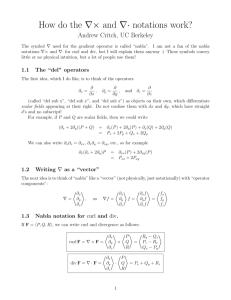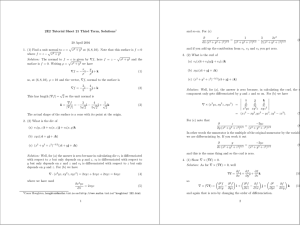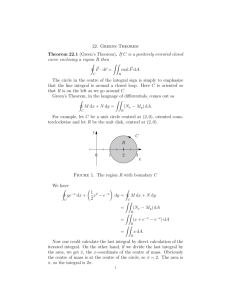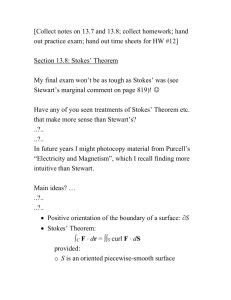GREEN-LAMI
advertisement
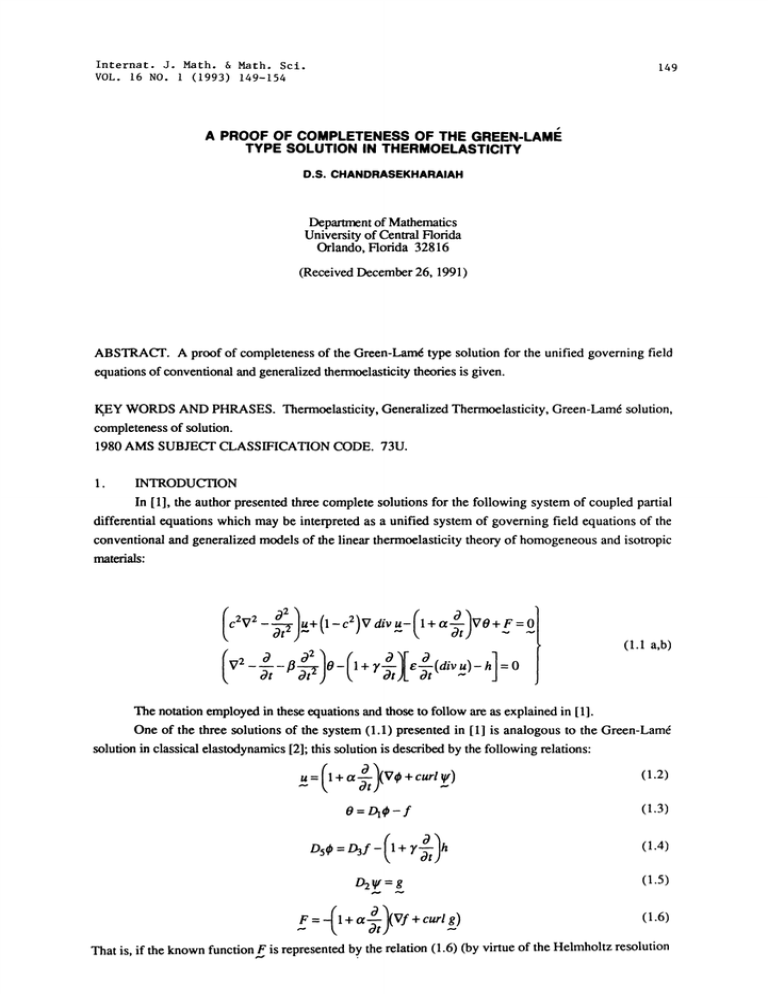
Internat. J. Math. & Math. Sci.
VOL. 16 NO.
(1993) 149-154
149
A PROOF OF COMPLETENESS OF THE GREEN-LAMI
TYPE SOLUTION IN THERMOELASTICITY
D.S. CHANDRASEKHARAIAH
Department of Mathematics
University of Central Florida
Orlando, Florida 32816
(Received December 26, 1991)
ABSTRACT. A proof of completeness of the Green-Lain6 type solution for the unified governing field
equations of conventional and generalized thermoelasticity theories is given.
,KEY WORDS AND PHRASES. Thermoelasticity, Generalized Thermoelasticity, Green-Lam6 solution,
completeness of solution.
1980 AMS SUBJECT CLASSIFICATION CODE. 73U.
INTRODUCTION
In ], the author presented three complete solutions for the following system of coupled partial
differential equations which may be interpreted as a unified system of governing field equations of the
conventional and generalized models of the linear thermoelasticity theory of homogeneous and isotropic
1.
materials:
(1.1 a,b)
The notation employed in these equations and those to follow are as explained in 1].
One of the three solutions of the system (1.1) presented in 1] is analogous to the Green-Lam6
solution in classical elastodynamics [2]; this solution is described by the following relations:
(.3)
O= D- f
h
(1.4)
1+
Dg
g
(.5)
Vf +curl g)
(1.6)
F=
That is, if the known function
’
DstP=D3f-
l+a
F is represented by the relation (1.6) (by virtue of the Helmholtz resolution
150
D.S. CHANDRASEKHARAIAH
-
of a vector field), then a solution {u_, 0} for the system (1.1) is given by the representations (1.2) and
(1.3) where and are arbitrary scalar and vector functions (respectively) obeying the partial differential
equations (1.4) and (1.5). Here D, D2, /93 and D5 are partial differential operators defined by ]"
D
D2
V2
c2V 2 92
D3 =V 2
"’
02
(1.7)
02
fl’-t
(1.9)
It was also shown in [1 that the solution described above is complete in the sense that if the
known function_,F is represented as in (1.6), then every solution {u_, 0} of the system (1.1) admits a
representation given by the relations (1.2) and (1.3) with # and obeying the equations (1.4) and (1.5).
The proof of completeness suggested in [1 was an extension of the proof given in [2] in the
(1.6) for F
the function g is divergence-free (that is, div g 0) and infers that also has to be divergence-free.
The object of the present Note is to give a proof of the completeness of the Green-Lain6 type
solution that does not make the hypothesis that div g 0 and consequently does not infer that div g O.
context of classical elastodynamics. This proof makes the hypothesis that in the representation
This proof is motivated by the work of Long [3] in classical elastodynamics and is analogous to that given
in [4] in the context of the theory of elastic materials with voids.
2.
PROOF OF COMPLETENESS
Consider
solution {u_, 0} of the system (1.1). By virtue of the Helmholtz representation of a
vector field, may be expressed as
u
_u=
+curl)
l+ot
(2.1)
for some scalar field p and a vector field q.
Substituting for u from (2.1) into equation (1.1a), we get the equation
(1 CttV{DlP-(0 ,)}+curl{D2q-g..}]
+
+
(2.2)
Here, we have made use of the representation (1.6) for F and the relations (1.7) and (1.8).
For ct 0, equation (2.2) gives
V{Dp- (0 + f)} curl{g- D2q }
For
ot
(2.3)
0, equation (2.2) yields equation (2.3) provided
[v{o,p- 0 +:)} + rtto q_-
o 0_.
This condition may be taken to be valid when u and 0 obey homogeneous initial conditions.
Taking the divergence of both sides of (2.3) and noting that div V 7 2 and div curl is the zero
COMPLETENESS
OF THE
GREEN-LAME TYPE SOLUTION
151
operator, we get the equation
This equation implies that [4, Appendix]
P=+0
(2.5)
/ 0+f
(2.6)
V2o =0.
(2.7)
where
Taking the curl curl of both sides of (2.3) and noting that curl V is the zero operator and
curl curl Vdiv- V 2 we obtain the equation
V2 curl(D2- g,_)
=.
(2.8)
This equation implies that [4, Appendix]
q= r0+ 1
(2.9)
V2(curl 0) 0_..
(2.10)
where
D2
(2.11)
=g
Substituting for p and q from (2.5) and (2.9) into the expression (2.3) and using (2.6) and (2.11)
we obtain the relation
V(Do + curl(D2 o O_..
Using the relations (1.7), (1.8), (2.7) and (2.10), this yields
--t {Vo + curl o }-=
from which it follows that
V o + curl o
(2.12)
where 2 and r3 are independent of t.
Taking the divergence of (2.12) and using (2.7), we get
divll2 +divll3 =0.
Since this holds for any t, we should have div r2
0 and div 3
0 from which it follows that
Ilr2 curl 2,
for some
(2.13)
2, dj3.
Taking the Laplacian of (2.12) and using (2.7) and (2.10), we get
V2 I]/2 + V2 t/f3
0
which on using (2.13) yields
curl
V23
152
D. S
for some
02
and
.
CHANDRASEKHARAIAH
Vg-z VOw,
Vz
VO
(2.14)
qt(P, t) by
We now define the function
vf(Q,t-R/C)dv
(2.15)
D
where
=t02 +3
(2.16)
and R is the distance from the field point P to a point Q, the integration (over D) being w.r.t.Q.
From (2.15) we get
curl
Itt=curl(lltl +t2 +3).
(2.17)
Substituting for p and q from (2.5) and (2.9) in the right-hand side of (2.1) and using (2.12),
(2.13) and (2.17), we obtain
This is the desired representation (1.2)
for.u.u. The desired representation (1.3) for 0 is given by (2.6).
Substituting for u and 0 from (1.2) and (1.3) into equation (1.1b) and using (1.9) and (1.10), we
obtain the equation
DsO-D3f+ 1+?’
This is precisely the desired governing equation (1.4) for
With the aid of the identity
V
o3
2
c 20t
)f q(Q,
D
R
.
h=0.
R[c)dV
-4 n q
and the relations (1.8), (2.14) and (2.16), expression (2.15) yields DN= D_l. Using the relation
(2.11), we now find that N obeys the equation/ lg g, which is the desired governing equation (1.5)
for
.
Thus, we have shown that, given any solution {, 0} for the system (1.1), one can construct
functions 0 and
such that and 0 can be represented by the relations (1.2) and (1.3) with 0 and
obeying the equations (1.4) and (1.5).
This completes the prf of completeness of the Green-Larn6 type solution for the system (1.1).
Note that no where in the proof it has been assumed that div g 0 and inferred that div has to be zero.
ACKNOWLEDGEMENT. This work is supported by the U. S. Government Fulbright Grant #15068
under the Indo-American Fellowship Program. The author is thankful to Bangalore University, Bangalore
and the University Grants Commission, New Delhi for nominating him for the Fellowship and the IndoU.S. subcommission on education and culture for awarding the Fellowship. His thanks are also due to
Professor Lokenath Debnath for the facilities.
COMPLETENESS OF THE GREEN-LAME TYPE SOLUTION
153
REFERENCES
CHANDRASEKHARAIAH, D. S." Complete solutions of a coupled system of partial differential
equations arising in Thermoelasticity, Ouart. Appl. Mirth. XLV (1987) 471-480.
GURTIN, M. E." The linear theory of elasticity, Encyclopedia of Physics, Vol. VI a/2, SpringerVerlag, New York (1972), p. 234.
LONG, C. F." On the completeness of the Lame potentials, Acta Mchanica 3 (1967) 371-375.
CHANDRASEKHARAIAH, D. S.: Complete solutions in the theory of elastic materials with
voids, Ouart. J. Mech. Appl. Math. 37 (1987) 401-416.
po’manent address of the author:
Department of Mathematics, Bangalore University, Central College Campus, Bangalore 560 001, India.

